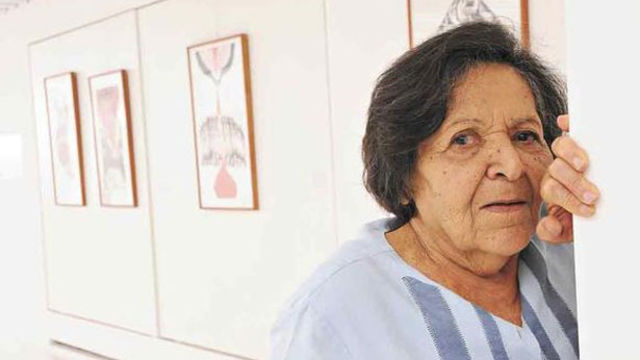
Wilma Martins
Born in Belo Horizonte, Brazil, in 1934, Wilma Martins began her artistic training between 1953 and 1956, when she attended the Escola do Parque (also known as the Escola Guignard) in her native city—an important art school that spurred the renewal of the local art scene. There she studied with the painter Alberto da Veiga Guignard (1896–1962), the sculptor Franz Weissmann (1911–2005), and the engraver Misabel Pedrosa (1927–2005), as well as the critic and art historian Frederico Morais. She worked as an illustrator and layout artist for newspapers and magazines in Belo Horizonte and in Rio de Janeiro, where she settled in 1966. Also in the 1960s she illustrated children's books and designed costumes for the Balé Klauss Vianna and the Teatro Experimental.
Although her initial focus was on woodcuts, drawing and painting are constant practices throughout Martins's career. As part of her work process the artist continually moves from one medium to another, using drawings sometimes as studies for paintings and other times as records of compositions that she executes directly on the canvas. This correlation is especially notable in her best known series, Cotidiano (Everyday, 1975–84), in which the artist brings intimacy and the natural world together in a remarkable way. In this group of works, Martins takes domestic spaces as her subject—the bathroom, the kitchen, a nook in the library—and records them in very subtle, almost invisible painting. Insinuating themselves through cracks and crevices, colorful animals, wild or domestic—or even a forest expanse, with rivers and mountains—spring forth. Portraying elements of nature on the scale of the interior environment further accentuates the strangeness of these compositions. In Martins's paintings, the natural world invades the everyday and disrupts the artificiality of the domestic arrangement.
Martins took part in various group exhibitions, such as the Bienal de São Paulo (in 1963, 1965, 1967—when she received the Itamaraty Acquisition Prize—1975, 1994, and 2016), Tradição e Ruptura: Síntese da arte e cultura brasileiras (Fundação Bienal de São Paulo, 1994), and iterations of the Panorama de Arte Atual Brasileira (Museu de Arte Moderna, São Paulo), where she was awarded a prize in 1976. She was also included in the Venice Biennial in 1978. In spite of this activity, her artistic career remains relatively unexplored.
—Valéria Piccoli
Selected Solo Exhibitions
1960 Wilma Martins, Instituto Brasil–Estados Unidos, Belo Horizonte
1976 Wilma Martins: obras, Galeria de Arte Global, São Paulo
1980 Museu de Arte Contemporânea do Paraná, Curitiba
1989 Wilma Martins, Museu da Inconfidência, Ouro Preto, Minas Gerais
2013–14 Wilma Martins: Retrospectiva. Cotidiano e Sonho, Paço Imperial, Rio de Janeiro, and Minas Tênis Clube, Belo Horizonte
Selected Bibliography
Morais, Frederico. Coleção Gilberto Chateaubriand: Retrato e autorretrato da arte brasileira. São Paulo: Museu de Arte Moderno, 1984.
———. Wilma Martins: Obras. With an introduction by Jayme Maurício and Roberto Pontual. São Paulo: Galeria Arte Global, 1976.
Vieira, Ivone Luzia. A Escola Guignard na cultura modernista de Minas 1944–1962. Pedro Leopoldo: Companhia Empreendimento Sabará, 1988.
Wilma Martins. With essays by Márcio Sampaio, Lélia Coelho Frota, and Francisco Bittencourt. Curitiba: Museu de Arte Contemporânea, 1980.
Wilma Martins: Cotidiano. With an introduction by Paulo Roberto Leal and essays by Silviano Santiago, Lélia Coelho Frota, and Roberto Pontual. Rio de Janeiro: Galeria Saramenha, 1982.


